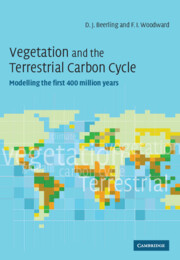Book contents
- Frontmatter
- Contents
- Preface
- Acknowledgements
- 1 Introduction
- 2 Investigating the past from the present
- 3 Climate and terrestrial vegetation
- 4 Climate and terrestrial vegetation of the present
- 5 The late Carboniferous
- 6 The Jurassic
- 7 The Cretaceous
- 8 The Eocene
- 9 The Quaternary
- 10 Climate and terrestrial vegetation in the future
- 11 Endview
- References
- Index
10 - Climate and terrestrial vegetation in the future
Published online by Cambridge University Press: 09 August 2009
- Frontmatter
- Contents
- Preface
- Acknowledgements
- 1 Introduction
- 2 Investigating the past from the present
- 3 Climate and terrestrial vegetation
- 4 Climate and terrestrial vegetation of the present
- 5 The late Carboniferous
- 6 The Jurassic
- 7 The Cretaceous
- 8 The Eocene
- 9 The Quaternary
- 10 Climate and terrestrial vegetation in the future
- 11 Endview
- References
- Index
Summary
Introduction
This chapter moves on to using the vegetation model to simulate likely changes of vegetation in the future. The scenario of future and transient climatic and CO2 change is from the 2nd Hadley Centre Coupled Model (HadCM2; Johns et al., 1997). The GCM output has been adjusted (W. Cramer) to a tight spatial and quantitative match with observed climatic data between 1931 and 1960 (Chapter 3; Cramer, et al., 2001). These same corrections are applied throughout the transient changes in climate from 1830 to the year 2100. These changes occur in response to a business-as-usual scenario of future increase in atmospheric CO2 and are themselves the results of economic models, such as for future fossil fuel use (Wigley, 1997). The period of simulation is extended from 2100 to 2200 by using a period of constant, or stabilised, conditions to provide a method for investigating the presence and nature of any delayed or inertial responses by vegetation to transients of climate and CO2.
The climatic scenarios
The major, driving variables for the vegetation model are atmospheric CO2 concentration (Fig. 10.1), terrestrial temperature (Fig. 10.2) and terrestrial precipitation (Fig. 10.3). Changes in sunshine hours, or cloudiness and atmospheric humidity are also derived by HadCM2 and used to force the vegetation model.
- Type
- Chapter
- Information
- Vegetation and the Terrestrial Carbon CycleThe First 400 Million Years, pp. 340 - 352Publisher: Cambridge University PressPrint publication year: 2001



